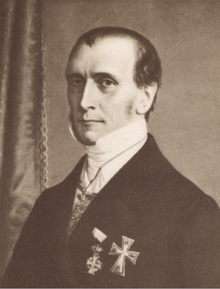Johannes Theodorus Suhr
| Johannes Theodorus Suhr | |
|---|---|
 Portrait of Theodor Suhr by Marstrand | |
| Born |
2 April 1792 Copenhagen, Denmark |
| Died |
10 November 1858 (aged 66) Copenhagen, Denmark |
| Nationality | Danish |
| Occupation | Merchant and industrialist |
| Known for | Den Suhrske Stiftelse |
Johannes Theodor(us) Suhr (2 April 1792 – 10 November 1858) was a Danish merchant and industrialist . He owned the Suhr House at Gammeltorv in Copenhagen as well as Sølyst north of the city and was the founder of Den Suhrske Stiftelse.
Rarly life
Suhr was born into a wealthy family of merchants in Copenhagen in 1792. His father was Pæd Berendt Suhr, owner of J. P. Suhr & Søn. The company traded with a wide range of products, including coal, salt, linum and hemp. It survived the difficult years during the war with England in the 1800s. Theordor Stuhr finished school and had plans to study theology.
Career
When their father died in 1815, he and his elder brother Didrik Suhr joined the management of the company which was formally owned by their mother until her death in 1842. The company went through a difficult period with the settlement of its activities in Norway followed by an agricultural crisis but experienced new growth in the late 1820s and early 1830s. The company increasingly specialized in import of coal and iron from Sweden and Rngland. In the 1930s, J. P. Suhr & Søn had a market share of more than 20% of the Danish import of coal and it later gre to 33 &. The company was also active as a money lender with ties to leading bankers in Hamburg.
In 1827, Suhr moved into the industrial sector when he leased the rolling mill in Frederiksbærg. He began manufacturing copper plates and in 1828 installed the first larger Danish built steam engine (20 jp=. In 1830, he acquired Brede Copper Mill. In the 1850s, Suhr sold these activities but continued to have investments in industrial enterprises such as Ørholm, Strandmøllen and M. P. Allerup. He had also investments in industrial enterprises abroad.
When his mother died in 1842, Suhr became the sole owner of the company after buying out his brother and sisters. At this point he had an estimated net worth of 800,000 Danish rigsdaler and by 1853 it had doubled to 1.6 million rigsdaler. In late 1855 he ceded the company to his nephew Ole Suhr but remained active in it for another few years.[1]
Personal life
Suhr married Christine Caroline Andrea Falch on 30 March 1816 in the Church of the Holy Ghost in Copenhagen. She was the daughter of grocer and bank commissioner Andreas Falck and his wife Charlotte Sophie Suhr (1756–1822). The couple had no children.
Suhr took active part in public life. He was a member of the Council of 32 Men from 1822 to 1835. He was active in the preparations for the first stændervalg and was also active in Trykkefrihedsadressen in 1835. He was appointed to Etatsråd in 1847
In 1840, he acquired the Schimmelmann family's country house Sølyst. He hept a large household and socialized with the cultural and political elite.
Suhr acquired Bonderup in 1853 and Merløsegård in 1856. He made a summer residence available to the Heiberg 's at Bonderupgård. He died on the estate in 1860. He is buried in Gentofte Cemetery. He left his fortune to a foundation, Den Suhrske Stiftelse. J. P. Suhr & Søn was dissolved in 1897 after selling its activities to A/S Det danske Kulkompagni.
References
- ↑ "Theodor Suhr" (in Danish). Dansk Biografisk Leksikon. Retrieved 12 October 2016.